2021 MERCEDES-BENZ GLC trailer
[x] Cancel search: trailerPage 54 of 462
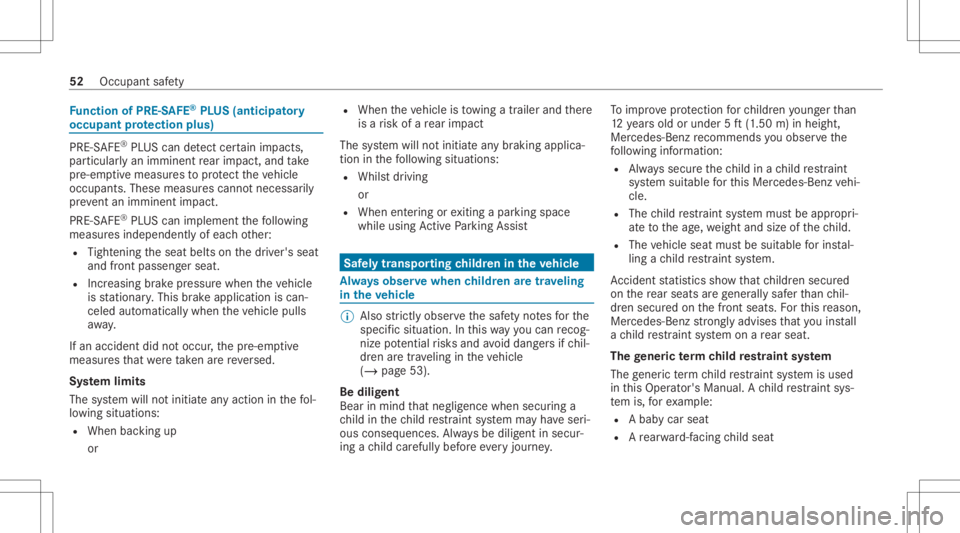
Fu
nction ofPRE-S AFE®
PL US (anticipat ory
occupant protection plus) PRE-
SAFE®
PL US can detect cer tain im pact s,
par ticular lyan imm inentrear impact ,and take
pr e-em ptive measur estoprotect theve hicle
occupants. Thesemeasur escanno tnecessar ily
pr eve ntan imm inentimpact.
PR E-S AFE ®
PL US can implem entthefo llo wing
measur esindepe ndently of eac hot her :
R Tight ening theseat belts onthedr iver's seat
and front passeng erseat.
R Increasin gbr ak epr essur ewhen theve hicle
is statio nary.This brak eapplication iscan‐
celed automaticall ywhen theve hicle pulls
aw ay.
If an accident didnotoccur ,th epr e-em ptive
measur esthat we retake nar ere ve rsed.
Sy stem limit s
The system will notinitiat ean yaction inthefo l‐
lo wing situat ions:
R When backingup
or R
When theve hicle istowing atrailer andther e
is arisk ofare ar impact
The system will notinitiat ean ybr aking applica‐
tion inthefo llo wing situat ions:
R Whils tdr ivin g
or
R When entering orexitin gapar kingspace
while using ActivePa rking Assist Saf
elytransp orting childr enintheve hicl e Alw
aysobser vewhen childr enaretrav eling
in theve hicl e %
Also strictly observe thesaf etyno tesfo rth e
specif icsituation. Inthis wa yyo ucan recog‐
nize potentia lri sk sand avoiddang ersif ch il‐
dr en aretrav eling intheve hicle
(/ page53).
Be dilig ent
Bear inmind that neg ligenc ewhen securing a
ch ild inthech ild restra int system mayha ve ser i‐
ous conseq uences. Alwaysbe dilig entinsecur‐
ing ach ild car efull ybef oreeve ryjou rney . To
improve protect ion forch ildr enyoung erthan
12 yearsold orunde r5 ft (1.50 m)inheight ,
Mer cedes- Benzre comme ndsyouobse rveth e
fo llo wing informatio n:
R Alw ayssecur eth ech ild inach ild restra int
sy stem suitable forth is Mer cedes -Benz vehi‐
cle.
R The child restra int system mus tbe appr opri‐
at eto theag e, we ight andsize ofthech ild.
R The vehicle seatmustbe suit able forins tal‐
ling ach ild restra int system.
Ac cid ent statis ticssho wthat childr ensecur ed
on there ar seat sar ege ner ally saf erthan chil‐
dr en secur edon thefront seats. Forth is reason ,
Mer cedes-Ben zst ro ng lyadvis esthat youins tall
a ch ild restra int system onare ar seat .
Th ege ner icterm child restra int system
The gener icterm child restra int system isused
in this Opera tor's Manua l.A ch ild restra int sys‐
te m is, forex am ple:
R Abab ycar seat
R Arear wa rd-faci ng child seat 52
Occupant safety
Page 79 of 462
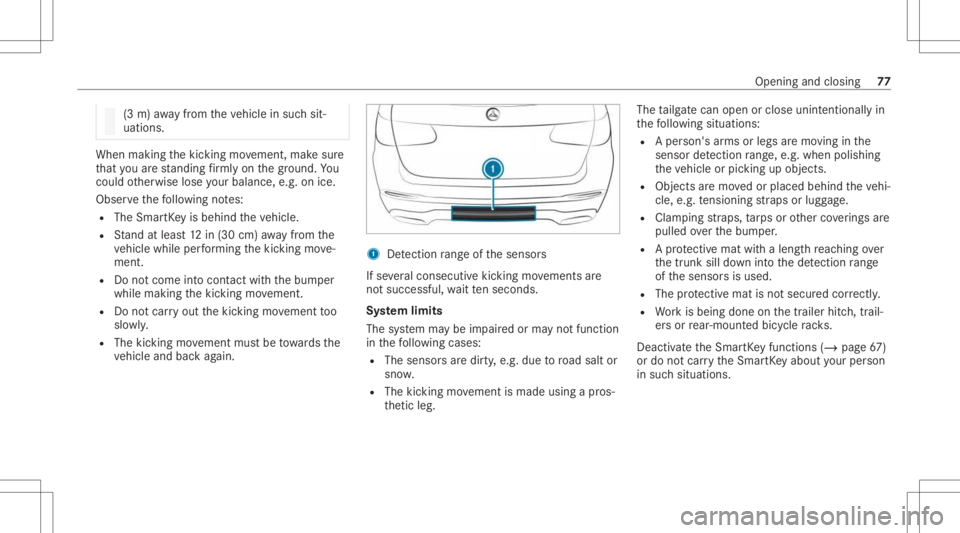
(3
m) away from theve hicle insuc hsit‐
uations. When
making thekic king movement, makesur e
th at youar est andi ngfirm lyon thegr ound. You
cou ldother wise loseyour balan ce,e.g.on ice.
Obs erve thefo llo wing notes:
R The Smar tKey isbehin dth eve hicle.
R Stand atleas t12 in(30 cm) away from the
ve hicle while perform ing thekic king move‐
ment.
R Donotcome intocont actwithth ebum per
while making thekic king movement.
R Donotcar ryout thekic king movement too
slo wly.
R The kicking movement mustbe towa rdsth e
ve hicle andbackag ain. 1
Detection rang eof thesensor s
If se veralcon secut ive kic kin gmo vements are
no tsuccessfu l,wa itte nseco nds.
Sy stem limit s
The system maybe impair edorma yno tfunc tion
in thefo llo wing cases :
R The sensorsar edir ty,e.g. due toroad salt or
sn ow .
R The kicking movement ismade using apr os‐
th etic leg. The
tailg atecan open orclos eunin tentio nallyin
th efo llo wing situat ions:
R Aper son 'sarms orlegs aremo vingin the
sensor detection rang e, e.g .wh en polishi ng
th eve hicle orpic king upobjects .
R Object sar emo vedor placed behind theve hi‐
cle, e.g. tensi oni ng stra ps orlugg age.
R Clam pingstra ps, tarp sor other coverings are
pu lled ove rth ebum per.
R Apr otect ive mat withalengt hre ac hin gove r
th etrunk silldown intoth ede tection rang e
of thesensor sis used.
R The protect ive mat isno tsecur edcor rectl y.
R Workisbeing doneonthetrailer hitch,trail‐
er sor rear-m oun tedbicy clerack s.
Deactiv ateth eSmar tKey functions (/page67 )
or do notcar rytheSmar tKey about your per son
in suc hsit uatio ns. Open
ingand closing 77
Page 163 of 462
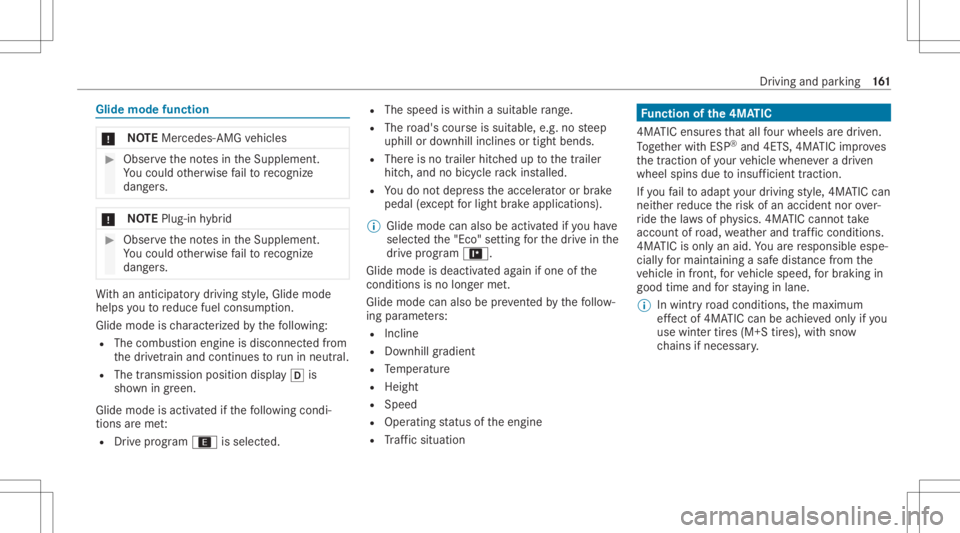
Glide
mode functio n *
NO
TEMercede s-AMG vehicles #
Obser vetheno tesin theSupplement .
Yo uco uld other wise failto recogni ze
da ngers. *
NO
TEPlug -in hybrid #
Obser vetheno tesin theSupplement .
Yo uco uld other wise failto recogni ze
da ngers. Wi
th an ant icip ator ydr ivin gst yle, Glide mode
helps youto reduce fuelconsum ption.
Glide mode isch aract erize dby thefo llo wing:
R The com bustion engin eis disco nnect edfrom
th edr ivet ra in and continues torunin neu tral .
R The trans mis sion positio ndispl ay005B is
sho wningreen.
Glide mode isact ivat ed ifth efo llo wing condi‐
tion sar eme t:
R Drive pr og ram ; issele cted. R
The speed iswit hin asui table rang e.
R The road's courseissuit able, e.g.no steep
uphill ordownhill inclinesortight bends.
R Ther eis no trailer hitched uptothetra iler
hitc h,and nobicy clerack installed.
R Youdo notdepr esstheaccelera toror brak e
peda l(e xc ep tfo rlig ht brak eapp lications).
% Glide mode canalsobe activ ated ifyo uha ve
select edthe"Eco" setting forth edr ive in the
dr ive pr og ram =.
Gli de mode isdea ctivated again ifone ofthe
condi tions isno long erme t.
Gl ide mod ecan also be preve nted bythefo llo w‐
ing parame ters:
R Incline
R Downhill gradi ent
R Temp eratur e
R Height
R Speed
R Oper ating status oftheengine
R Traf fic situ ation Fu
nction ofthe4MA TIC
4MA TICensures that all four wheel sar edr iven .
To get her withESP ®
and 4ETS,4MA TICimprove s
th etraction ofyour vehicle whene vera dr iven
whee lspins duetoinsuf ficie nttracti on.
If yo ufa ilto adap tyo ur drivin gst yle, 4MA TICcan
neit her reduce therisk ofan accident norover‐
ri de thelaws ofphysics. 4MA TICcannotta ke
acc oun tof road, weather and traf fic condi tions.
4MA TICisonly anaid. Youar ere sponsible espe‐
cially formaint ainingasaf edis tance from the
ve hicle infront, forve hicle speed, forbr aking in
good timeandforst ay ing inlane.
% Inwint ryroad con dition s,themaximum
ef fect of 4MA TICcan beachie vedonl yif yo u
use wint ertires (M+ Stir es), withsn ow
ch ains ifnec essar y. Dr
iving and parking 16
1
Page 177 of 462
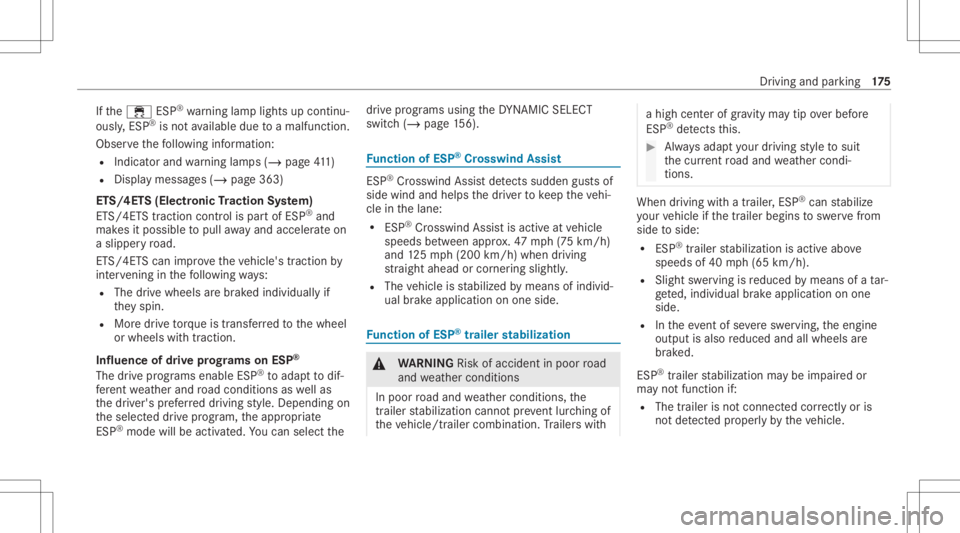
If
th e00E5 ESP®
wa rning lam plight sup con tinu‐
ousl y,ESP ®
is no tav ailable duetoamalf unction.
Obse rveth efo llo wing informatio n:
R Indicat orand warning lam ps(/ page41 1)
R Displ aymessa ges(/ page363)
ET S/4ET S(Ele ctronic Tractio nSy stem)
ET S/ 4ETS tracti oncontr olispa rtof ESP ®
and
mak esitpossible topull away and accelerat eon
a slippe ryroad.
ET S/ 4ETS can improve theve hicle's traction by
int erve ning inthefo llo wing ways:
R The drive wheels arebr ak ed individually if
th ey spin.
R Mor edr ive to rq ue istrans ferred tothewheel
or wheels withtra ction.
Inf luence ofdrive pr og rams onESP®
The drive pr og rams enabl eESP ®
to adap tto dif‐
fe re nt we ather and road con dition sas wellas
th edr iver's prefer reddr iving style. Depen dingon
th eselect eddrive pr ogr am, theappr opriate
ES P®
mode willbeactiv ated. Youcan selectthe dr
ive pr og rams using theDY NA MIC SELE CT
switc h(/ page15 6). Fu
nction ofESP ®
Cr osswind Assist ES
P®
Cr osswind Assistde tects sudde ngu stsof
side wind andhelps thedr iver tokeep theve hi‐
cle inthelane:
R ESP®
Cr osswind Assistis activ eat vehicle
speeds between appr ox.47 mp h(7 5 km/h)
and 125mp h(200 km/h) whendriving
st ra ight ahead orcor ner ing slight ly.
R The vehicle isstabiliz edbymeans ofindivi d‐
ua lbr ak eapp lication onone side. Fu
nction ofESP ®
trailer stabil izatio n &
WARNIN GRisk ofacci dent inpoo rro ad
and weather condition s
In poor road and weather condition s,the
tr ai le rst abiliz ationcan notpr ev ent lurching of
th eve hicle/tr ailercombination. Trailer swit h a
high centerof grav ity ma ytip ove rbef ore
ESP ®
de tects this. #
Alw aysadap tyo ur drivin gst yle to suit
th ecur rent road and weather condi‐
tio ns. When
drivin gwit hatrailer ,ES P®
can stabiliz e
yo ur vehicle ifth etrailer begins tosw erve from
side toside:
R ESP ®
traile rst abiliz ationis act ive abo ve
speeds of40 mph(65 km/h).
R Slight swerving isreduced bymeans ofata r‐
ge ted, individual brak eapplication onone
side.
R Intheeve ntofsevere sw erving, theengine
output isalso reduced andallwheels are
br ak ed.
ES P®
tra iler stabiliz ationma ybe impair edor
ma yno tfun ction if:
R The trailer isno tcon nectedcor rectl yor is
no tde tected prope rly by theve hicle. Dr
iving andparking 17
5
Page 189 of 462
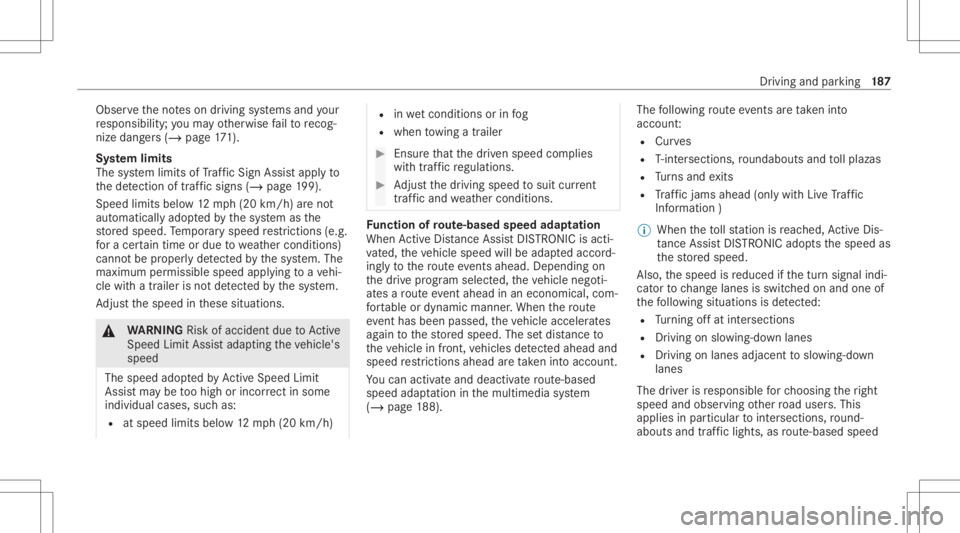
Obser
vetheno teson driving systems andyour
re sponsibili ty;yo uma yot her wise failto recog‐
nize dangers(/ page 171).
Sy stem limit s
The system limits ofTraf fic Sign Assistappl yto
th ede tection oftraf fic sig ns (/ page 199).
Spee dlimits below 12mp h(20 km/h) areno t
aut omaticall yadop tedby thesy stem asthe
st or ed speed. Temp oraryspeed restrictions (e.g.
fo ra cer tain tim eor due towe ather condition s)
can notbe proper lyde tected bythesy stem. The
maximum permissible speedapplying toave hi‐
cle withatrailer isno tde tected bythesy stem.
Ad jus tth espeed inthese situation s. &
WARNIN GRisk ofacci dent dueto Active
Spe edLimi tAssi stadap tingth eve hicle's
speed
The speed adoptedby ActiveSpe edLimi t
Assi stma ybe toohigh orincor rect insome
indi vidualcase s,su ch as:
R atspee dlimit sbelo w12 mp h(20 km/h) R
inwe tcond itions orinfog
R when towing atrailer #
Ensur eth at thedr iven speed complies
wit htraf fic re gulations. #
Adjus tth edr iving speed tosuit current
tr af fic and weather condition s. Fu
nction ofrout e-base dspee dadap tation
When ActiveDis tance AssistDIS TRONI Cis acti ‐
va ted, theve hicle speed willbeadap tedaccor d‐
ing lyto thero uteev ent sahead. Dependingon
th edr ive pr og ram sele cted, theve hicle negoti‐
at es aro uteeve ntaheadin an eco nomi cal,com‐
fo rtable ordynam icman ner.When thero ute
eve nthasbe en passe d,theve hicle acceler ates
ag ain tothestor ed speed. Thesetdis tance to
th eve hicle infront, vehicles detected aheadand
spe edrestrictions aheadar eta ke nint oacco unt.
Yo ucan activat eand deac tivatero ute-based
spee dadap tatio nin themultimedia system
(/ page18 8). The
follo wing routeeve nts areta ke nint o
acco unt:
R Curves
R T-int ersect ions,ro und about sand tollplazas
R Turnsand exits
R Traf fic jams ahead(only with Liv eTr af fic
Inf ormation )
% When theto llst atio nis reac hed, ActiveDis ‐
ta nce AssistDIS TRONI Cad op tsthespeed as
th estor ed speed.
Also, thespeed isreduced ifth etur nsignal indi‐
cat ortochang elane sis swit ched on and one of
th efo llo wing situat ionsisde tected:
R Turning offat intersect ions
R Drivin gon slowing- down lanes
R Drivin gon lanes adjacenttoslo wing-do wn
lanes
The driver isresponsible forch oosing theright
speed andobser vingother road user s.This
applies inpar ticular tointersect ions,ro und ‐
about sand traffic lights, asroute-based speed Dr
ivin gand parking 18
7
Page 190 of 462
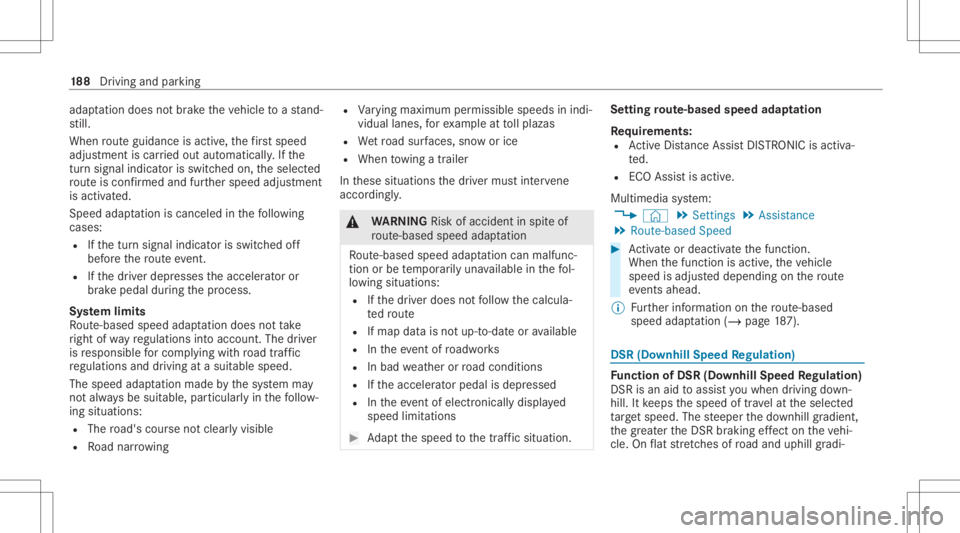
adap
tatio ndo es notbr ak eth eve hicle toast and‐
st ill.
When routeguidan ceisact ive, thefirs tsp ee d
ad jus tment iscar ried out automaticall y.Ifth e
tur nsigna lind icatoris switc hedon,theselect ed
ro uteis co nfirmed andfurther speed adjustment
is activ ated.
Speed adaptatio nis canc eled inthefo llo wing
cases :
R Ifth etur nsignal indicat orisswitc hedoff
bef oreth ero uteev ent .
R Ifth edr iver depr esses theaccelera toror
br ak epeda ldur ing thepr ocess.
Sy stem limit s
Ro ute-based speedadap tatio ndo es nottak e
ri ght ofwa yre gulations intoaccount .The driver
is responsible forcom plying withro ad traf fic
re gulations anddriving atasuit able speed.
The speed adaptatio nma de bythesy stem may
no talw aysbe suit able, particular lyin thefo llo w‐
ing situat ions:
R The road's coursenotcle arly visi bl e
R Road nar row ing R
Varying maxim umpermissib lespeeds inindi‐
vidual lanes, forex am ple attollplazas
R Wetro ad sur faces, snowor ice
R Whe nto wing atrailer
In these situation sth edr iver mus tint erve ne
acco rding ly. &
WARNIN GRisk ofacci dent inspi teof
ro ute-based speedadap tatio n
Ro ute-based speedadap tatio ncan malfunc‐
tio nor be temp orarily una vailable inthefo l‐
lo wing situat ions:
R Ifth edr iver does notfo llo wthecalcula‐
te dro ute
R Ifmap datais no tup-t o-dat eor available
R Intheeve ntofroadw orks
R Inbad weather orroad con dition s
R Ifth eaccelera torpeda lis depr essed
R Intheeve ntofelectr onicallydispla yed
speed limitations #
Adaptth espeed tothetraf fic situ ation. Se
tting rout e-base dspee dadap tation
Re quirement s:
R ActiveDis tance AssistDIS TRONI Cis acti va‐
te d.
R ECOAssis tis activ e.
Multimedia system:
4 © 5
Set ting s5
Assist ance
5 Route-based Speed #
Activateor deacti vate thefunc tion.
When thefunc tion isactiv e,theve hicle
speed isadjus teddependin gon thero ute
eve nts ahead.
% Further information onthero ute-based
spee dadap tatio n(/ page 187). DSR
(Dow nhill Speed Regulat ion) Fu
nction ofDSR (Downhill Speed Regulat ion)
DS Ris an aid toassis tyo uwhen drivin gdo wn‐
hill. Itke eps thespeed oftrav el at theselect ed
ta rget speed. Thesteeper thedo wnhill gradient,
th egr eat ertheDS Rbr aking effect on theve hi‐
cle. Onflat stre tche sof road and uphill gradi‐ 18
8
Driving and parking
Page 193 of 462
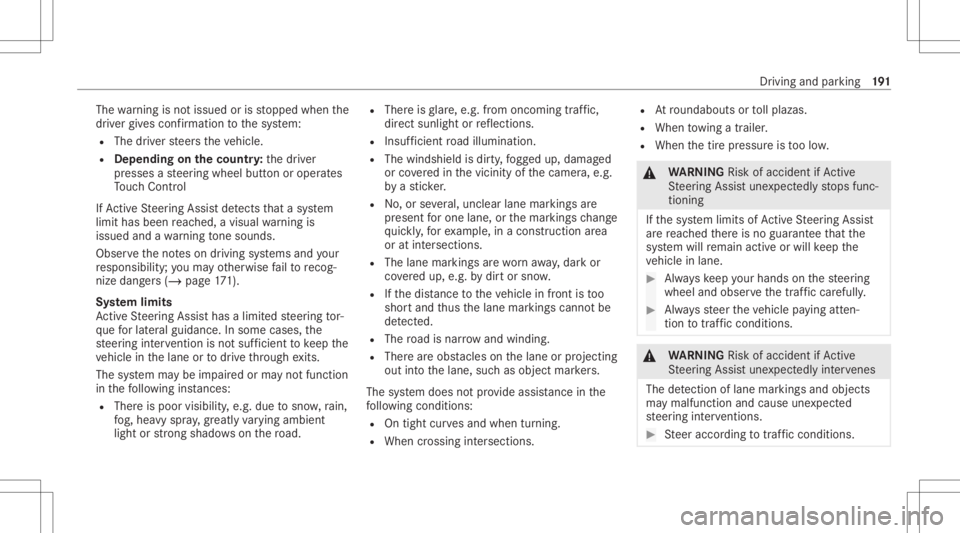
The
warning isno tissued orisstopped whenthe
dr iver giv es con firm atio nto thesy stem:
R The driver steer sth eve hicle.
R Depending onthecount ry:th edr iver
pr esses ast eer ing wheel buttonoroper ates
To uc hCon trol
If Ac tiveSt eer ing Assis tde tects that asy stem
limit hasbeen reac hed, avisual warning is
issued andawa rning tone sou nds.
Obs erve theno teson driving systems andyour
re sponsibili ty;yo uma yot her wise failto recog‐
nize dangers(/ page 171).
Sy stem limit s
Ac tiveSt eer ing Assis thas alimit edsteer ing tor‐
qu efo rlat eral gui dance. Insome cases, the
st eer ing interve ntio nis no tsu fficien tto keep the
ve hicle inthelane ortodrive th ro ugh exits.
The system maybe impair edorma yno tfunc tion
in thefo llo wing instances:
R The reispoor visibilit y,e.g. due tosno w,rain,
fo g, hea vyspr ay,gr ea tly varying ambien t
light orstro ng sha dows onthero ad. R
Ther eis glar e, e.g .fr om oncom ingtraf fic,
di re ct sunli ght orreflect ions.
R Insuf ficie ntroad illumin ation.
R The wind shieldisdir ty,fo gg ed up, damag ed
or coveredin thevicinit yof thecamer a,e.g.
by ast icke r.
R No,or several,unc lear lane markingsare
pr esen tfo rone lane, orthemar king sch ang e
qu ickl y, forex am ple, inacon stru ction area
or atintersecti ons.
R The lane mar kings arewo rnaw ay,dar kor
co veredup, e.g. bydirtor sno w.
R Ifth edis tance totheve hicle infront istoo
shor tand thus thelane marking scann otbe
de tected.
R The road isnar row and wind ing.
R Ther ear eobs tacle son thelane orprojec ting
out intoth elane, suchas objec tmar kers.
The system does notpr ov ide assis tance inthe
fo llo wing condition s:
R Ontigh tcur vesand when turning.
R When crossing intersections. R
Atround about sor tollplazas.
R When towing atrailer .
R When thetir epr essur eis toolow. &
WARNIN GRisk ofacci dent ifAc tive
St eer ing Assis tune xpect edlyst ops func‐
tionin g
If th esy stem limits ofActiveSt eer ing Assis t
ar ere ac hed ther eis no guar anteethat the
sy stem will remain activeor wil lke ep the
ve hicle inlane. #
Alw ayske ep your han dson thesteer ing
wheel andobser vethetra ffic car efull y. #
Alw aysst eer theve hicle paying atten‐
tion totraf fic condi tions. &
WARNIN GRisk ofacci dent ifAc tive
St eer ing Assis tune xpect edlyinterve nes
The detection oflane mar kings andobje cts
ma ymal functi onand causeune xpect ed
st eer ing interve ntio ns. #
Steer accor dingtotraf fic condi tions. Dr
iving and parking 19
1
Page 206 of 462
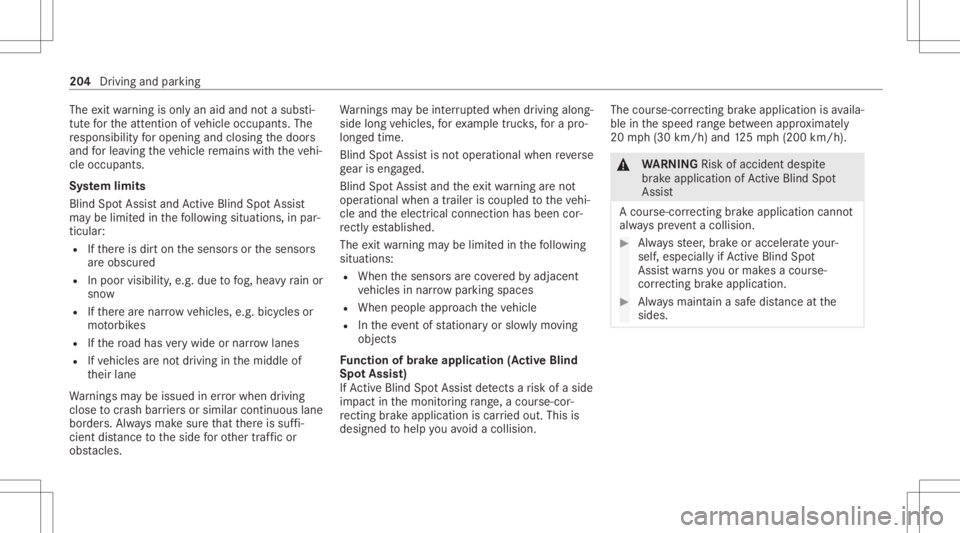
The
exitwa rning isonl yan aid and nota subs ti‐
tut efo rth eatt ent ion ofvehicle occupants. The
re sponsibili tyforopening andclosi ngthedoor s
and forlea ving theve hicle remains withth eve hi‐
cle occupants.
Sy stem limit s
Blin dSpo tAs sis tand ActiveBli nd Spo tAssi st
ma ybe limi tedin thefo llo wing situat ions,in par‐
tic ular :
R Ifth er eis dir ton thesensor sor thesensor s
ar eobscur ed
R Inpoor visibility ,e.g. due tofog, hea vyrain or
sno w
R Ifth er ear enar row vehicles, e.g.bicycles or
mo torbik es
R Ifth ero ad has very wide ornar row lanes
R Ifve hicles areno tdr iving inthemiddle of
th eir lane
Wa rnings maybe issued inerro rwhen driving
close tocrash barrier sor similar continuous lane
bor ders.Alw aysmak esur eth at ther eis suf fi‐
cie ntdist anc eto theside forot her traf fic or
obs tacle s. Wa
rnings maybe interru pte dwhen driving along‐
side long vehicles, forex am ple truc ks,fo ra pr o‐
long edtime.
Blind SpotAssis tis no toper ationa lwhen reve rse
ge ar iseng aged.
Blin dSpo tAs sis tand theex itwa rning areno t
opera tionalwhen atrailer iscoupled totheve hi‐
cle and theelectr icalconnect ionhas been cor‐
re ctl yes tablished.
The exitwa rning maybe limit edinthefo llo wing
situat ions:
R When thesensor sar eco veredby adjac ent
ve hicles innar row par kingspac es
R When people approachth eve hicle
R Intheeve ntofstatio naryor slo wlymo ving
obj ect s
Fu nction ofbrak eapp lication (Activ eBlind
Spo tAssis t)
If Ac tiveBli nd Spo tAssi stdetects arisk ofaside
im pact inthemonit oring rang e, acou rse-co r‐
re cting brak eap plica tion iscar ried out. This is
designed tohelp youavo idacollis ion. The
cour se-cor recting brak eap plica tion isavaila‐
ble inthespeed rang ebe twee nap prox imat ely
20 mph(3 0km/h) and125mp h(2 00 km/h) . &
WARNIN GRisk ofacci dent despite
br ak eapplication ofActiveBli nd Spo t
Assi st
A cou rse-co rrect ing brak eapplication cannot
alw ayspr ev ent acollision. #
Alw aysst eer ,br ak eor accelera teyour‐
self ,espe ciallyif Ac tiveBli nd Spo t
Assi stwa rnsyo uor mak esaco urse-
co rrect ing brak eapplication. #
Alw aysmaint ainasaf edis tance atthe
sides. 20
4
Driving andparking